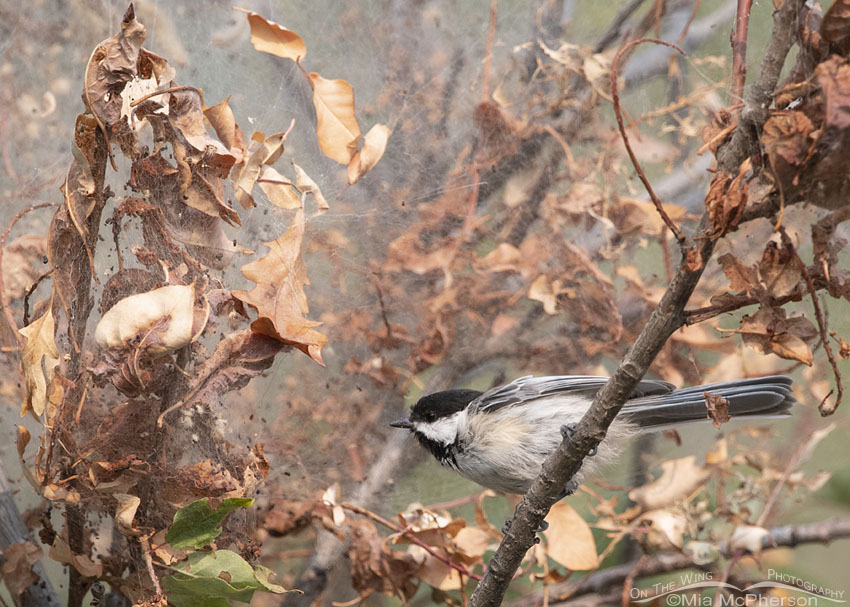There are already signs that the season is transitioning from late summer to early autumn up in the high country of Utah, mornings are cooler, birds are on the move and fattening up for their migrations, some of the oaks have already begun to turn a rusty color and the last time I was up there I only saw one hummingbird the whole morning. It has been a great summer for me as a bird photographer if you push aside the smoke from wildfires and the days of extreme temperatures.
 Black-capped Chickadee & Western Tent Caterpillar tent – Nikon D500, f7.1, 1/1000, ISO 800, Nikkor 500mm VR with 1.4x TC, natural light
Black-capped Chickadee & Western Tent Caterpillar tent – Nikon D500, f7.1, 1/1000, ISO 800, Nikkor 500mm VR with 1.4x TC, natural light
I’ve spent more time in the mountains than any previous year since I moved to Utah and that has given me opportunities with birds that I don’t normally get to photograph down in the valleys, the marshes surrounding the Great Salt Lake or out in the sagebrush scented deserts. It has also given me opportunities with species I see in the yard but instead of being near a feeder they are in their natural habitat.
Before I found the Baltimore Oriole on the 23rd of August I had been driving slowly on the dusty gravel road stopping at nearly every clump of bushes or trees where I saw bird activity. I sat in my Jeep quietly to see what birds might fly in, some times it takes a minute or two or four or five before the birds feel comfortable enough to resume their normal activity and that is okay with me because it relaxes me to take time to soak in my surroundings.
At one of the clumps of mixed deciduous trees I watched as tanagers, buntings and warblers flitted about but were hidden by the foliage, the obstructing leaves and branches made it hard to photograph them but I enjoyed seeing them moving about doing what birds do.
Then I heard a familiar call, caught a flash of black, gray and white and spotted a Black-capped Chickadee land right in front of a Western Tent Caterpillar tent while calling out a clear “chickadee-dee-dee” to another chickadee that was nearby. I focused on the chickadee as it moved about foraging on the outside of the caterpillar tent and the dried up leaves of the chokecherry host tree.
Some people may find the setting in this photo unnerving because they may have an aversion to tent caterpillars like I myself do but this photo shows the chickadee in its natural habitat and that is good enough for me. I was only able to take about a dozen photos of this chickadee before it moved on to another tree and then flew out of my view. It was worth my time to stop and wait.
Life is good.
Mia
Click here to see more of my Black-capped Chickadee photos plus facts and information about this species.


To my eye the composition of this image is just perfect. I think the detail and textures you captured are wonderful. Thanks Mia.
I feel a physical aversion to tent caterpillars because I have seen pounds of them hanging from eaves. I see mainly webs here. The chickadee is refreshing, one of the joys of winter when all the other birds fly away. but if the Chickadees like them, freast on!
It is always lovely to see birds in their natural habitat – though they adjust to our habitat well.
Cute
Great photograph as it shows how the bird uses its habitat, changing things a little.
Neat photo! I like the surrounding colors with the chickadee…natural is always good. I am always surprised by the subtle differences I see in nature with your area and mine. I never knew what a difference the altitude makes in regards to nature. What has surprised me the most is the serviceberries. The fact that those out there are recently now edible compared to ours being LONG gone. Who knew…?